realspido
Newbie level 5

Hi everyone.
I'm trying to find a way to share a resistive liquid level sensor across two different circuits; obviously connecting the two circuits in parallel to the sender units won't work, so I was wondering if there's a way to design an electronic circuit that will read the resistance of the sender unit and simulate it to TWO galvanically separated outputs.
Rin = Rout1 = Rout2
I've seen resistance transmitters but they use voltage or current in the outputs - I'm after resistive outputs.
Any help would be greatly appreciated.
Regards,
Tom
I'm trying to find a way to share a resistive liquid level sensor across two different circuits; obviously connecting the two circuits in parallel to the sender units won't work, so I was wondering if there's a way to design an electronic circuit that will read the resistance of the sender unit and simulate it to TWO galvanically separated outputs.
Rin = Rout1 = Rout2
I've seen resistance transmitters but they use voltage or current in the outputs - I'm after resistive outputs.
Any help would be greatly appreciated.
Regards,
Tom


